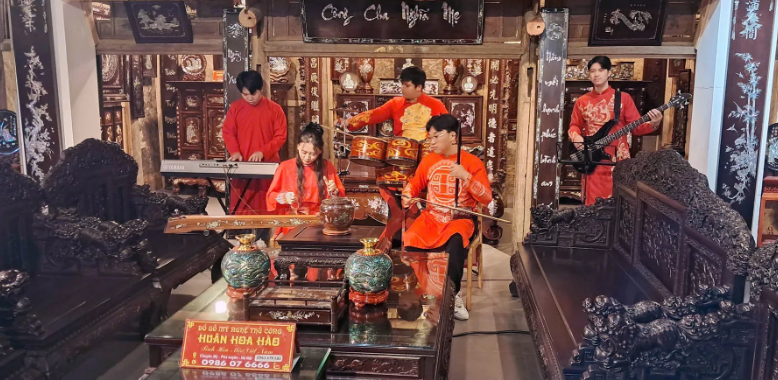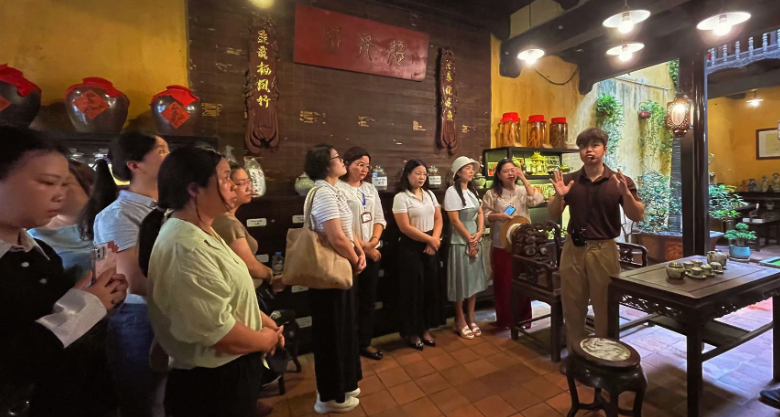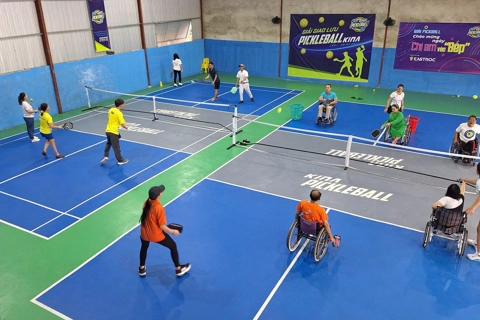Hanoi acts to protect its historic heart
No other place in Vietnam rivals Hanoi in terms of the density of its valuable heritage sites, which serve as a unique resource for the city’s sustainable growth.
THE HANOI TIMES — Hanoi is implementing a series of measures to preserve and promote the Old Quarter, the cultural heart of the capital, now located within Hoan Kiem and Cua Nam wards, following the recent shift to a two-tier local administrative model.

Traditional cultural performance at the Old Quarter Cultural Exchange Center (50 Dao Duy Tu Street). Photos: Hoai Nam/The Hanoi Times
Living museum
The Old Quarter spans approximately 100 hectares and includes 76 streets bordered by Hang Dau to the north, Phung Hung to the west, and Hang Bong, Hang Gai, Cau Go, and Hang Thung to the south. Tran Quang Khai and Tran Nhat Duat streets border it to the east. Often described as a "living museum," the area reflects the historical layers of Thang Long–Hanoi's formation and growth.
Across the two wards, over 190 historical and cultural relics are preserved. Notable sites include the Hoan Kiem Lake complex, featuring the King Le Temple; the O Quan Chuong gate; the Hanoi Opera House; the Hoa Lo Prison; St. Joseph's Cathedral, 48 Hang Ngang (where President Ho Chi Minh wrote the Declaration of Independence), the National Museum of History, the Museum of the Vietnamese Revolution, and the Dong Xuan Market, among others.
The Old Quarter's charm lies in its traditional architecture and cultural heritage woven into daily life, reflecting local identity while bridging Eastern and Western cultures to attract visitors worldwide.
As for intangible heritage, traditional art forms such as UNESCO-recognized ca tru, hat xam, and hat van are revitalized; traditional festivals, including those at Bach Ma Temple, Kim Ngan Communal House, the Mid-Autumn Festival in the Old Quarter, and the Le Thai To Temple Festival, are held annually, highlighting spiritual depth and community spirit.
In Hoan Kiem, daily life is deeply connected to cultural expressions, such as folk performances on walking streets. Corners are linked to old craft villages, creating a dynamic cultural space where the past and present coexist. Traditional guild streets, such as Hang Bac, Hang Gai, Hang Thiec, Hang Ma, and Hang Chieu, remain vibrant commercial hubs that preserve Hanoi’s urban fabric and age-old way of life.
Following an administrative merger, Cua Nam Ward now covers 1.65 square kilometers and has a population of 65,667. It encompasses the entire area and population of the former wards of Tran Hung Dao, Hang Bai, and Phan Chu Trinh; most of the former Cua Nam Ward; and parts of Hang Bong, Hang Trong, and Trang Tien (formerly Hoan Kiem District), as well as Pham Dinh Ho and Nguyen Du (formerly Hai Ba Trung District).

Tourists visiting Dinh Co Vu Temple. Photo: Cong Tho/The Hanoi Times
Meanwhile, Hoan Kiem Ward spans 1.93 square kilometers and has 71,280 residents. It encompasses the entirety of the former wards of Hang Ma, Hang Bo, Hang Dao, Hang Bac, Hang Buom, Hang Gai, and Ly Thai To, as well as most of Dong Xuan, Trang Tien, Cua Dong, Hang Bong, and Hang Trong. The ward also includes parts of the former Cua Nam and Dien Bien wards.
Both wards lie at the heart of the capital’s administrative, political, and cultural life, a space where Hanoi’s architectural, historical, and human values continue to flourish.
Promoting cultural heritage
At the official launch of Cua Nam Ward early this month, Party Secretary and Chairman of the ward People’s Council Pham Tuan Long outlined five key priorities: urban management tied to heritage conservation; administrative reform and digital transformation; development of a modern economy based on tourism and trade; improvement of the quality of culture, education, and healthcare; and safeguarding national defense and public security.
"The ward aims to lead in digital innovation, the nighttime economy, pedestrian and heritage-art streets, and public space enhancements, while preserving the charm of its French-influenced architecture," said Long.
Following the administrative reorganization, Hoan Kiem Ward, home to Hoan Kiem Lake, remains a landmark of revolutionary, cultural, and historical significance, representing Hanoi and the nation. The ward retains the distinct identities of its local neighborhoods, especially the cultural legacy of Hanoi's 36 ancient streets.

Tourists visiting the 87 Ma May ancient house. Photo: Hoai Nam/The Hanoi Times
According to Professor Dr. Nguyen Quang Ngoc of the Vietnam Association of Historical Sciences, Hanoi exemplifies Vietnam's historical and cultural essence, with heritage reflecting the Red River civilization and relics linked to royal capitals, ancient cities, and historic towns.
"No other locality in Vietnam matches Hanoi’s density of valuable heritage sites, which serve as a unique resource for the city’s sustainable growth," said Ngoc.
However, despite years of restoration efforts in the former Hoan Kiem District, heritage potential remains underutilized due to deteriorating ancient houses, limited funding, fragmented management, and underdeveloped tourism services, with unresolved issues in sanitation, food safety, and waste management.
Ngoc noted that harmonizing tourism and residential life in the Old Quarter requires balancing development with cultural identity, while many believe Hanoi must adopt comprehensive measures, through media, exhibitions, museums, and festivals, to raise public awareness and promote ethical, responsible tourism.
"Improving the management of tourism and travel services is crucial. Planning must align with Hanoi’s overall development vision for 2030 and beyond, emphasizing the restoration and protection of historic urban areas, clear codes of conduct, and balancing daily life with heritage preservation," Ngoc said.
The city is planning to allocate more resources, including the private sector, to ensure conservation quality.
Experts have suggested that developing cultural tourism offerings and strong heritage-based branding through craft experiences, cuisine, storytelling, and guided tours can help attract visitors and link community benefits with business opportunities.
Meanwhile, reviving traditional craft villages will further connect local livelihoods with cultural tourism.
Long, from Cua Nam Ward, said that Hanoi is boosting its promotional efforts through media campaigns, cultural events, and creative spaces, and is integrating the Old Quarter into the city’s tourism map.
In addition, technology is being incorporated into heritage management, training, market research, and digitization while preserving the visual integrity of relics to ensure protecting the enduring values of heritage and shaping Hanoi into a historic, civilized urban destination.











